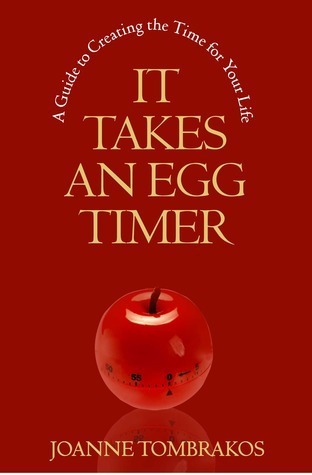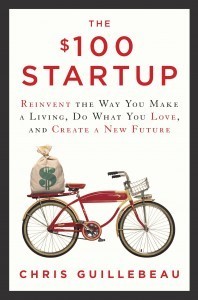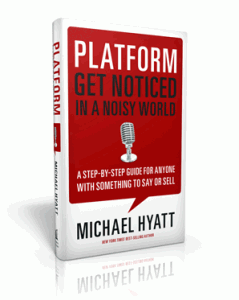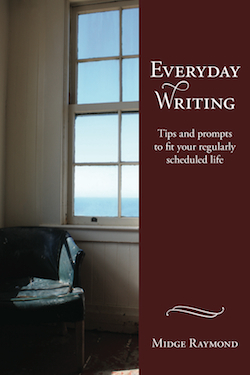Jane Friedman's Blog: Jane Friedman, page 188
June 11, 2012
There Are Two Kinds of “Busy.” Is Yours the Good Kind?
The following is excerpted from It Takes an Egg Timer: A Guide to Creating the Time for Your Life by Joanne Tombrakos (@JoanneTombrakos). It’s a brief but essential guide about how to get stuff done, while also helping you understand when and how self-sabotage occurs! Find out more on Amazon, or visit the author’s website.
Technology’s intent was to simplify our lives. And if used properly, it can maximize our time. I’m a big fan of technology. But one of its big downsides is how it can create the illusion that we are so much more important than we really are.
We go nowhere without our cell phones. In fact, I can break out in a cold sweat if I lose my precious iPhone for one minute in the bottom of my purse. We are connected 24/7, and we interpret that to mean we need to be engaged with it 24/7. If we are not careful, the mobile phone becomes the most important item in our life, instead of the people and work we want to engage with. We get consumed with the busyness it creates and not in creation. Worse, it produces those knots of anxiety in our belly, among the biggest time wasters of them all.
Don’t get me wrong. I believe each and every one of us to be important beings on this planet. But our interconnected world that has shown us its benefits also distorts that importance to mean being on call 24/7 to everything and everyone.
This is where we can lose sight of what we need to be most engaged with—ourselves, our work, and the people in our lives who are important to us, not our smartphone or our computer.
“I’m really too busy for all this.”
Another part of this self-important obsession is this idea of “busy.” At the moment, it is my number one pet peeve. Ask someone, anyone, right now, how they are and the first thing liable to come out of their mouth is, “I’m so busy.” Ask them what they are so busy with and all they can offer is a furrowed brow and one of those exhausted breaths that seems to have been added on for dramatic effect.
By definition, “busy” can be a verb or an adjective. It can be synonymous with occupied, involved, engaged, and concerned.
But it can also denote preoccupied, distracted, diverted, overblown, overwrought, overdone, and fussy.
Most of us say we are busy because we live in a place that is hectic and cluttered. If our busyness were more positive—being involved and engaged—our response would be specific about the great stuff we are absorbed in. But it’s not, because we are too busy to even get that specific.
Take a moment. Write down specifically what kept you “busy” today. Then determine which definition of “busy” it falls under.
Basic Rules of the Egg Timer
The point of using an egg timer is to busy ourselves with what engages us, not what distracts us from our purpose and our path. The basic rules are:
Turn off your e-mail.
Do not answer the phone unless you are awaiting a call on the cure for cancer.
Set the timer. Do not get up until it rings.
Work-Life Balance
Let’s be clear. There is no such thing as work-life balance, so if you think the egg timer is the solution, think again. The idea of work-life balance is that it is a destination we arrive at. I don’t believe that. Like life itself or love, it is about the journey. In other words, I think of it more as a seesaw.
There are precious moments when it is level, and you really and truly believe you have a handle on it all. But for the most part, one is always weighing more than the other, depending on the hour of the day or the day of the week or the month in the year. The egg timer can assist you to have control over which parts of your life are requiring more attention at any given moment. But work-life balance? If you continue to see it as a destination, the egg timer will not do much to improve upon it.
To keep enjoying more insights from this book—with more detail on how to use the egg timer to best effect—I encourage you to check out Joanne’s book on Amazon. The first chapter is available for free.
June 10, 2012
Love Letter to Cincinnati (#4)
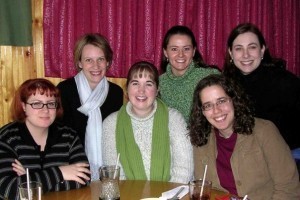
My colleagues at F+W, sometime around 2005
It will be hard to think back on Cincinnati without thinking about F+W, the whole reason I moved to the city in the first place.
It was a promising and lucky career start, even though I wanted to leave the company— and city—initially. I had dreams of joining Peace Corps or teaching English in Korea. But I stuck with F+W, because I was attached to someone else who couldn’t leave Cincinnati.
That ended up being a good thing. We tend to shine in times of dedication and consistency, even when it’s forced upon us. Maybe we can look back and feel value and accomplishment in what we did, even if it wasn’t entirely our choice.
For 10-plus years, my waking life in Cincinnati revolved around career development. This is how I’ve always preferred it, and I’ve always genuinely enjoyed my work.

Team W. D'issou (inspired by Life Aquatic)
As a result, my closest friends in Cincinnati are—and mostly remain—the people I worked with at F+W. Over the years, my colleagues and I discussed everything and anything, including office crushes. Mine was a guy who worked in production. I remember the first time I ever saw him. He briskly approached my desk with page proofs and pointed out mistakes I had made. I felt like a moron—as if I held the wrong job. (At the time, I’d held my editorial job for about two years.) I apologized, smiled, and promised to take care of the errors. He nodded and left without any chit-chat.
From day one, production guy terrified me. I knew I couldn’t live up to his expectations. He was going to be circling my every mistake from that day on out.
Fortunately, I changed positions, moved away from detail-oriented work, and didn’t have to endure his critical eye for long. However, the people I managed still worked with him directly. One day, my managing editor came to me in tears. Production guy wouldn’t let her make last-minute corrections on a book before it was sent to the printer, due to a new corporate policy. So I went downstairs to talk to him, and asked him to make an exception, just this once.
He stared at me in silence. I stared at him.
We stared for a good long while.
He sighed.
I promised this would be the only time I’d come begging on behalf of my managing editor.
He said this was the only time it would work.
Not long thereafter, I left F+W. Things weren’t bad, but I felt bad. I desperately wanted to be content, yet I wasn’t. So I left. It was a straightforward decision once I found another job I knew I would love: teaching at UC.
I’ve only been at UC for two years, and things have gone well. I feel good. I am content. I haven’t wished for anything else. And furthermore, Cincinnati is headed for its national moment in the spotlight. It couldn’t possibly look any better for this town, and every time I read a new article about its boom, I wonder again, “Why am I leaving?” E.g.,
New York Times: Cincinnati Comes Back to Its Ohio River Shoreline
Cleveland.com: Cincinnati Fights Its Way Back Into Hearts of the Hip and Trendy
Urban Cincy: The Triumph of Cincinnati’s Center City Plan
Over the Rhine blog: Bill Cunningham Praises Progress in OTR
It’s a strange thing to leave—a place, a job, a situation—when things are good. If you’ve found contentment and peace, what motivation is there to leave? Isn’t that asking for trouble? Why disturb calm waters?
Around the time I was deciding whether to stay or go, I happened to read an issue of one of my favorite e-mail newsletters, Be Slightly Evil, which is hard to describe, but is basically a life philosophy newsletter. Here’s a snippet of what I read.
… [A]cting for the sake of acting (otherwise known as creative destruction), and choosing churn over stability, is central to life. This is not “good” because it does not equal a belief in change as progress. But it is also not “evil” because it is not a belief in value-driven stability. Action … favors chaos creation.
To read the original passage in its original context, click here.
The concept of creative destruction goes back to the Hindu god Shiva, simultaneously destroyer and creator. Today, the term is now used regularly (and sometimes sickeningly) in business to put a dynamic, edgy spin on disruptive changes.
It’s funny how often, when speaking to people about my move, they say, “It’ll be a new adventure!” I use the same language too. As a culture, I think we tend to value adventure. Much popular entertainment is built on the call to adventure. But I’m not convinced it’s better to seek out adventure. It means saying yes to creative destruction, welcoming chaos, and hastening loss. (I’m reminded of the lyrics to a favorite Mason Jennings song: “Loss is brutal, I can’t stand it, I wonder how you can.”)
Unlike my career, my relationships (especially romantic ones) have been driven by adventure, risk, and loss; churn over stability; a continuous learning process—not just about myself, but the pattern of existence as reflected by a relationship’s beginning, middle, and end. It keeps teaching you something, long after it’s officially over. What the relationship was changes. How you see yourself changes.
I recently finished watching a series, Any Human Heart. It makes a good argument for how each of us is changing all the time. We’re never the same person twice. But it would be hard (impossible) to function if we were truly aware and cognizant of the fact.
When I left F+W for UC in 2010, I found myself all too aware of this reality. I was completely adrift and losing my center. Too much change, not enough anchor. A wild-hair notion came to me. I asked my office crush, the production guy, on a date. He said yes.
His name is Mark, by the way.
Nearly two years later, Mark has also said yes to moving to Charlottesville with me. (Don’t worry; he’ll still be working for F+W and catching editors’ mistakes.) I like the idea of our relationship overlapping cities. It feels like parts of life aren’t irretrievably gone and lost all at once. Plus, embarking on a new life in a new city as part of a partnership is a new kind of adventure for me. Charlottesville is something we’ll discover and experience together, and Cincinnati is something we’ll remember together.
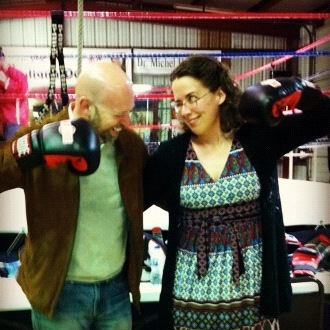
Mark & Jane at the Ragin' Cajun Boxing Club (Lafayette, LA)
June 8, 2012
How One Introverted Author Successfully Markets His Work
Kitty Cornered: How Frannie and Five Other Incorrigible Cats Seized Control of Our House and Made It Their Home, released this spring.
I don’t think you keep it a secret that you’re an introvert. Lots of writers who are introverts tell me they are bad at marketing (or dislike it) because they’re not extroverted. Thoughts on this issue?
For me the introvert-extrovert thing doesn’t apply a whole lot to online activity. What’s more introverted than sitting alone in a room and typing with the shades down? The reason that I have trouble with online marketing is a remarkable lack of self-confidence. If my sales ranking tanks on Amazon on any given day, I think, well, that proves it. My stuff isn’t any good, and I’m a despicable person. As a self-disrespecting neurotic, I wrestle with these feelings constantly.
Well, your stuff is pretty awesome. You had some stellar reviews and coverage for your first book, Kitty Cornered does as well once it gets a more exposure. The novelty of writing a pet memoir about ducks has to be a big factor in its success. And so is the humor. There are lots of great pet books out there, but few that come from the perspective of a clueless, bumbling soul like myself who is outsmarted by his animals at every turn. Despite the jokes, my huge love for our pets comes through, and people respond to that.
I think it’s mostly been word of mouth that’s taken Kitty Cornered, and they came up with the terrific idea of having the six cats from my book write a monthly advice column for other cats. So “Ask Six Cats” will be a regular feature on the Algonquin Books Blog.
We’re also using Twitter in a really fun way. Each Friday from 12:30-1:00 p.m., a different cat from Kitty Cornered. I also found it was perfect for quick little quips that didn’t fit into a book. I was surprised at the level of response I got, and I began to really enjoy the process. Three years later, I’m inching toward the Kitty Cornered and she gave me the names of the recipients in case I wanted to friend them on Facebook, too.
I’m just starting out with Twitter (@BobTarte), and I’m still figuring out how to use it. Pinterest baffles me, but I’ll give it a go.
I get a ton of questions from writers about how to balance writing with marketing. Is it something you even think about? Has marketing taken up more time with each new book? Does it eat into your writing time?
It definitely cuts into writing. I’m not in the right mental space right now to start working on another book, because I’m putting so much psychic energy into promotion. I’m good at it when it involves creative activities, like guest blogging. Despite my painful shyness and winning humility, I do well at book signings and workshops, especially when more than three people show up. But I’m a miserable failure at forcing myself to perform repetitive tasks such as e-mailing all the vets in the country and letting them know that I wrote book about cats.
 If you’re a pet owner or pet lover, check out Bob’s website, where you can find out more about his books, podcasts, and other offerings. And anyone with a cat should be sure to visit the Ask 6 Cats blog.
If you’re a pet owner or pet lover, check out Bob’s website, where you can find out more about his books, podcasts, and other offerings. And anyone with a cat should be sure to visit the Ask 6 Cats blog.
Or, take a look at each of his books on Amazon:
June 6, 2012
How Long Does It Take to Get Blog Readers?
How to Blog a Book by Nina Amir, recently released from Writer’s Digest Books. Aside from describing in detail how to launch and maintain a blog to ultimately land a book deal, Amir’s book offers a range of valuable interviews with successful bloggers who succeeded in doing just that. Here are their insights into how long it took them to get readers, and what seemed to be a turning point in the life of their blog.
Pamela Slim, Cubicle Nation blog
“It took about a year to develop a steady group of readers. It was very slow at first, but I found great joy in writing so I kept producing posts. One big tipping point for me was getting featured on venture capitalist and author Guy Kawasaki’s blog in May 2006. He was extremely influential in my target market. When he featured my post An Open Letter to CEOs Across the Corporate World on his blog, traffic and subscribers exploded. After that exposure, my growth was quicker and supported by influencers like Seth Godin, Kathy Sierra, and Hugh Macleod.”
Reggie Solomon, UrbanGardenCasual.com
“It took me about two years to build an audience. … Engaging social networks definitely helped. I opened groups on Flickr for people to share photos of their urban gardening and tomato adventures and honestly forgot about the group I’d set up. I was utterly surprised in checking my Flickr page a year later to find hundreds of people were submitting photos to my groups regularly. A similar occurrence happened after setting up my Facebook and Twitter pages as well. … We may all wish for a silver bullet to bolster readership, but it’s less a case of scoring a home run and more a case of getting singles on the board.”
Brett McKay, The Art of Manliness
“The site took off fairly quickly after I started it. The very first post I wrote, How to Shave Like Your Grandpa, got picked up on Digg and Reddit, which brought in a ton of traffic. (This was back when getting on the front page of Digg was a huge deal).”
Martha Alderson, The Plot Whisperer
“As soon as other writers started blogging about the help I provided them through my first book, Blockbuster Plots Pure & Simple, plot consultations, conferences, workshops, and retreats, my readership began growing. Writer’s blogs and websites bigger than mine, like The Daily Coyote, The Writers Store, and NaNoWriMo (National Novel Writing Month), started linking to my website and continue to send writers to the Plot Whisperer blog today. Writer’s Digest magazine awarded the Plot Whisperer blog the honor of a spot as one of the 101 Best Websites for Writers for three years running and directs new visitors to the blog each year.”
Christian Lander, Stuff White People Like
“It took about three weeks to go from 100 hits a day to 30,000 hits a day. From there it blew up to hundreds of thousands of hits. The day it exploded was the day it was featured on Comedy Central’s Insider. Truthfully, the traffic from major media outlets was nice, but sites like StumbleUpon always added more traffic than any traditional media source. So while big media can start the spark, it’s people sharing the posts over social media that causes a blog to really grow.”
June 5, 2012
Hustling: How to Spread the Word About Your Work
The following advice is excerpted from The $100 Startup: Reinvent the Way You Make a Living, Do What You Love, and Create a New Future by Chris Guillebeau. For longtime readers of my blog, you probably know how often I recommend Chris’s invaluable and free manifesto, 279 Days to Overnight Success . His latest book, The $100 Startup , offers practical advice on how to build a business doing what you love with only a modest investment.
Giveaway: One commenter will be randomly selected to receive a free hardcover copy of The $100 Startup . To be eligible, your comment must be made no later than June 6, 2012. The winner will be announced right here on June 7.
What does hustling mean? There are a few ways to look at it, but I like the approach in this poster by Joey Roth:
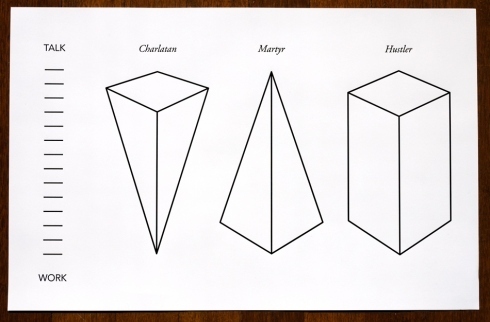
by Joey Roth
This distinction between the three icons represents the difference (and the likely success or lack of success) of a person or business hoping to promote something for sale. A charlatan is all talk, with nothing to back up their claims. A martyr is all action with plenty of good work to talk about, but remains unable or unwilling to do the talking. A hustler represents the ideal combination: work and talk fused together.
Being willing to promote in an authentic, non-sleazy manner is a core attribute of microbusiness success. Sometimes the best hustling lies in creating a great offer and getting people to talk about it. In my work, the hustler image on the right is pretty much what I try to do every day as a writer and entrepreneur: lots of creating and lots of connecting. The connecting (i.e., the talk) isn’t always directly related to the work at hand—sometimes I’m supporting other people with their hustling—but on a good day, there’s plenty of creating and plenty of connecting.
Another way to look at it is:
Style without substance = flash
(Also, no one respects these people.)
Substance without style = unknown
(Everyone who knows these people respects them, but not many people know them.)
Style with substance = impact
(This is the goal.)
When you’re first getting started with a project, how do you go from martyr to hustler? It’s simple. First things first: Take the time to make something worth talking about—don’t be a charlatan. But then start with everyone you know and ask for their help. Make a list of at least 50 people and divide them into categories (colleagues from a former job, college friends, acquaintances, etc). As soon as the project is good to go, at least in beta form, touch base by sending them a quick note. Here’s a sample message:
Hi [name],
I wanted to quickly let you know about a new project I’m working on.
It’s called [name of business or project], and the goal is to [main benefit]. We hope to [big goal, improvement, or idea].
Don’t worry, I haven’t added you to any lists and I won’t be spamming you, but if you like the idea and would like to help out, here’s what you can do:
[Action Point 1]
[Action Point 2]
Thanks again for your time.
Note that you’re not sending mass messages or sharing anyone’s private info with the world; each message is personal, although the content is largely the same. You’re also not “selling” anyone on the project; you’re just letting people know what you’re up to and inviting them to participate further if they’d like to. The action points can vary, but they should probably relate to joining a contact list (this way you have their permission to touch base with them further) and letting other people know about the project.
Getting to know people, helping them, and asking for help yourself can take you far. But it is a long-term strategy, not a short-term tactic to copy for quick success. Hustling and relationship-building strategies take time.
If you’re not sure where to spend your business development time, spend 50% on creating and 50% on connecting. And remember, the most powerful channel for getting the word out usually starts with people you know.
Giveaway: One commenter will be randomly selected to receive a free hardcover copy of The $100 Startup . To be eligible, your comment must be made no later than June 6, 2012. The winner will be announced right here on June 7.
June 4, 2012
Fiction Is About What We Can’t Say

Silas Dent Zobal
If you write fiction, then you don’t want to miss the latest Glimmer Train bulletin, which features three wonderful essays focusing on craft. One of the essays, by Silas Dent Sobal, is a powerful meditation on both how things die and how one writes fiction. Here’s how it starts:
I have a sense that what I ought to do here, on these pages, is speak with you about what it means to write, and about why I keep doing it year after year, and why you shouldn’t unless you feel you must. Maybe, along these lines, I could also offer some entrenched, toadish advice, which I’d only half believe in, about opening sentences, and subjects and predicates, and…
Well, here’s the thing: I don’t want to talk to you about any of this. I want to talk to you about dying.
I encourage you to read the full essay—click here.
Also check out two other essays:
“Risk” by Joshua Henkin: “My graduate students, many of whom are quite talented, are for the most part so afraid of being over the top that they’re subtle to the point of obfuscation. They think they’re being subtle, but the reader has no idea what they’re talking about. I believe writers should risk being over the top.”
“Whose Are You” by Natalie Bakopoulos: “The Greek poet George Seferis wrote in his diary: ‘Man is always double: he who acts, and he who sees himself acting; he who suffers, and he who sees himself suffering; he who feels, and he who observes himself feeling.’”
Tip: If you enjoy the essays on craft in the Glimmer Train bulletin, I highly recommend checking out one of the compilations that was published.
June 1, 2012
Facebook Strategy for Authors: In-Depth Discussion
If you’re like most authors I know, you’ve wondered about how to best use Facebook. Should you stick to your personal page, should you create a fan page, how do you promote a fan page, and what exactly does a marketing strategy look like on Facebook?
I’ve written several posts addressing the basics, as well as my personal strategy:
5 Principles for Using Facebook
3 Principles for Facebook Fan Pages
Too Many Facebook Friends: Blessing or Curse?
Writer Sarah Bartlett read these posts, and had further questions about Facebook strategy, which I was happy to answer. Our discussion is now available at her blog. Here’s a snippet:
First and foremost, realize that no matter what Facebook does with your profile page, or how the Timeline evolves, most people are interacting with your posts in their own newsfeed. Very few people visit your profile unless they have a reason to research you or be curious based on something you’ve posted. That means: Don’t sweat your Timeline too much. Yes, do fill out as much information on the about page that you’re comfortable sharing (especially for the public view), but beyond being clear about who you are, I don’t think the Timeline/profile format is meaningful from a marketing standpoint.
Here are three keys to behavior on Facebook that you need to understand, based on best business practices as well as what I’ve observed and experienced …
Click here to find out about those 3 keys to behavior, and read the full Q&A.
Side note about interview requests
For many years, I accepted all interview requests that landed in my inbox. Recently, I’ve had to become more selective due to the volume of requests, and also because responding to any Q&A is a signficant time commitment. Unfortunately, many people ask questions that I’ve already answered thoroughly at this blog and elsewhere, or they ask such broad or vague questions that a good answer would easily constitute a book! (E.g., “What do you think about the future of publishing?”)
Sarah’s request was easy to say yes to. She had already read material from me on a specific topic, and had very focused questions on that topic.
Keep that in mind whenever asking anyone to commit to a Q&A that offers you valuable content for your website or blog. Demonstrate knowledge of what that person has said in the past, and explore new or focused territory. That keeps it interesting and worthwhile for everyone.
May 30, 2012
Top 10 Blog Traffic Killers
The following advice is from Michael Hyatt’s newest release, Platform: Get Noticed in a Noisy World . The book is one of the most comprehensive guides on building an effective platform I’ve seen. Both beginning writers and established authors will find excellent and insightful instruction.
Assuming you want to increase your blog traffic, there are certain mistakes you must avoid to be successful. If you commit these errors, your traffic will never gain momentum. Worse, it may begin to plateau or begin to decrease.
How do I know? After writing more than 1,200 posts and receiving almost 100,000 comments, I have made most of the mistakes you can make—numerous times. As a result, certain patterns emerged.
1. You don’t post often enough.
Frequency is what separates the men from the boys … or the women from the girls. You cannot build solid traffic without frequent posts. I have seen time and time again that there is a direct correlation between frequency and traffic.
2. You post too often.
Yes, this is possible too. People don’t need to hear from anyone more than once a day—unless it is a group blog or a news site. You would do better to focus on writing one really great post a day rather than several mediocre ones. The trick is to find your frequency sweet spot. For me, it is four to five posts a week.
3. Your post is too long.
I shoot for less than 500 words. But I often post up to 600-700 words. Sometimes more. You can get away with this if your posts are scannable—that is, you make use of subheads, lists, and other devices that keep people moving through your content.
4. You don’t invite engagement.
Engagement refers to a combination of page views, reader comments, and social media mentions. The posts that generate the most engagement for me are those that are controversial, transparent (especially about failure), and/or open-ended. That is why I try to end every post with a question.
5. You don’t participate in the conversation.
When bloggers don’t comment on their own posts and respond to their readers, it is like hosting a party at your home, making a brief appearance, and then disappearing. In any other context, that behavior would be perceived as rude or odd. The same is true in blogging.
6. You don’t make your content accessible.
I often get asked if I think people are reading less. The simple answer is no. In fact, I think they are reading more than ever. But they are reading differently. Readers have shorter attention spans. They are scanning content, looking for items that interest them.
7. You don’t create catchy headlines.
According to Brian Clark, who runs the must-read site CopyBlogger, “on average, 8 out of 10 people will read the headline copy, but only 2 out of 10 will read the rest.” This means your headlines are the most important thing you write. Fortunately, Brian has an entire series of posts called How to Write Magnetic Headlines.
8. Your first paragraph is weak.
This is critical. Assuming you have written a great headline, people will next read your first paragraph. You must use this paragraph to pull them into the rest of your blog post. Start with a story, a promise, or a startling fact. Many bloggers spend too much time trying to set up the post or provide context. Just get to the point.
9. Your post is off-brand.
If you are trying to build a platform, you need to find an editorial focus and stick to it. A tighter focus leads to higher traffic. This is why I have tried to narrow my own focus to four areas: leadership, productivity, social media, and publishing. If I want to write on something else (e.g., fitness), I do so through one of these four lenses.
10. Your post is about you.
Unless you are a megacelebrity, readers don’t care about you. Not really. They are about themselves. They want to know what’s in it for them. your personal stories can be a doorway to that, but in the end, the best posts are about your readers’ needs, fears, problems, or concerns. Always ask, “What’s the takeaway for my reader?”
There are other mistakes too; I doubt this list is exhaustive. But if you can avoid these, you will be well on your way to increasing your traffic and growing your home base.
If you liked this post, you’ll love Platform . Read more at Amazon and download a free sample.
May 29, 2012
No Excuse Not to Write: 10 Five-Minute Writing Prompts
The following is excerpted from Everyday Writing by Midge Raymond. The book is meant for anyone with a passion to write but never quite enough time. Find out more at the publisher’s website or view on Amazon.
Why take the time for writing prompts?
Writing exercises can help our writing in ways we don’t know until we do them. They can allow our minds to retreat from the puzzle of a current project and wander a bit, perhaps leading us back to the puzzle from a different angle and getting us closer to a solution. Writing prompts can help us discover new material for an old piece, or new material for a new piece—or they can help inform whatever it is we’re working on. Sometimes, best of all, they can take us places we never knew existed, and lead us right into the next poem, story, or novel.
Once, in response to one of my e-newsletter’s writing prompts (“Describe what’s on your bedside table. And why.”), a writer told me she didn’t actually do the exercise, but she did clean up her bedside table. I loved that—it’s progress of a different sort, but who’s to say that having a clean bedside table can’t lead to clearer thoughts and better dreams? And, perhaps by extension, more vivid writing.
Here are 10 writing prompts from Everyday Writing, which offers 150 prompts, as well as advice on how to fit writing into your day.
Describe what you looked like at the age of five.
Write about a really bad first date.
Write about a poem you’ve always remembered.
Describe your most annoying Facebook friend.
Write about an e-mail you wish you hadn’t sent.
Describe your childhood bedroom.
Describe a ritual you have.
Write about what you’re wearing on your feet, if anything.
Describe your last bad haircut.
Write about a time you were late.
May 28, 2012
Love Letter to Cincinnati (#3)
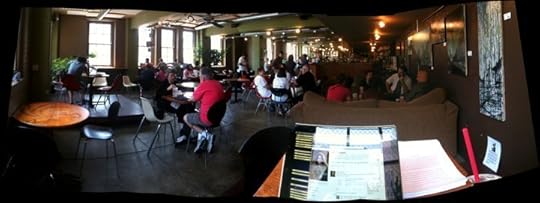
A panorama of Coffee Emporium in OTR (Cincinnati)
Note: Read the earlier installments in this series, #1 and #2.
My favorite places in Cincinnati are mostly tied to ritual. But I didn’t even believe in ritual until recently, around the time I read Eat, Pray, Love by Elizabeth Gilbert. She writes:
This is what rituals are for. We do spiritual ceremonies as human beings in order to create a safe resting place for our most complicated feelings of joy or trauma, so that we don’t have to haul those feelings around with us forever, weighing us down. We all need such places of ritual safekeeping. And I do believe that if your culture or tradition doesn’t have the specific ritual you are craving, then you are absolutely permitted to make up a ceremony of your own devising, fixing your own broken-down emotional systems with all the do-it-yourself resourcefulness of a generous plumber/poet.
In addition to ritual, I also became a believer in routine—probably ritual’s twin sister, hardly distinguishable. I used to think routines would make me boring, predictable, and uncreative. Quite the contrary. If you’ve read any of Jonathan Fields’ Uncertainty, you realize that routine represents a certainty anchor—a stabilizing and trustworthy force that leaves you free to take risks elsewhere.
For the last few years, my ritual or routine, whichever you’d prefer to call it, has revolved around Coffee Emporium, a coffeehouse about a 5-minute walk from my apartment, in OTR. I take my laptop and start the day in a lively environment where the baristas know my order, the sun shines bright, and the ceilings are high.

Inside Coffee Emporium (OTR / Cincinnati)
It’s probably the first ritual I ever consciously created for myself. When I first arrived in the city, in 1998, I had no activity that anchored me except for a morning run. Later, when M and I were together, we fell into a Friday night ritual of movie, dinner, and bookstore browsing. It could’ve been duplicated in any city, but I never realized how central that had become to my week’s structure until it was gone.
I don’t know that anyone faces the end of a marriage with a clear understanding of how life changes, but I did nothing to mark the change in my life, nor did I seek any new rituals or support. I had yet to see any importance or relevance in rituals, and furthermore, my modus operandi was to ignore beginnings & ends until I had a nice, good, long distance from them.
Fortunately, though, I did move to a new neighborhood (OTR), which forced me to discover new places and activities that I could truly call mine, and that I came to love.
The first and most important of these was the Roebling Bridge, part of my daily running route. Roebling is the suspension bridge over the Ohio River, connecting Cincinnati with Covington, Kentucky. When built, it was the longest suspension bridge in the world, at 1,057 feet, and it’s considered the precursor to the Brooklyn Bridge.

Roebling Bridge at sunset (and under construction in 2010), Ohio River
I’ve probably taken more pictures of the Roebling than any other structure in Cincinnati. While I worked at F+W, I even brainstormed a new imprint called Rubico that used the outline of the Roebling towers as its logo.
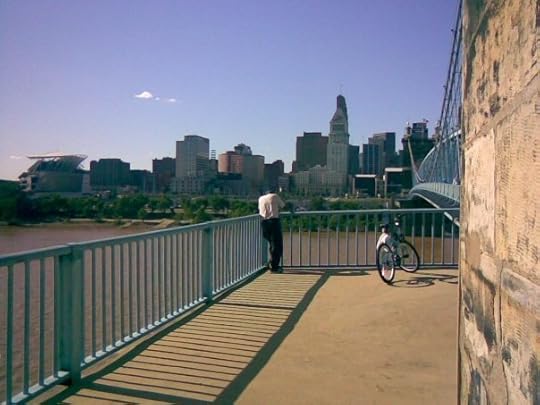
View of downtown Cincinnati from the Roebling Bridge
As months and years passed, many little places downtown began to play a role in relationship rituals—having drinks at certain places on a date (Grammer’s—while it was still open—and Neons), returning to a particular restaurant for special romantic celebrations (The Palace, Nicola’s), reserving intimate conversations for this or that lounge (The Celestial, The Cricket at The Cincinnatian).

The Conductor plays piano in the Cricket Lounge at The Cincinnatian
There are some rituals I always wanted to have in Cincinnati, but never managed to develop. I wanted to spend Saturday mornings at Findlay Market, but could never seem to get up early enough (or feel motivated enough to join the crowds).
I also wanted to have more rituals connected to the holidays and Cincinnati traditions, but that never happened either. I usually saw the Labor Day fireworks by accident while driving south on I-71; I never attended a Reds Opening Day parade; I never went to Oktoberfest even though it was only blocks away from home, I never went to a Taste of Cincinnati.

One of the few Labor Day fireworks celebrations I attended in Cincinnati, in 2011. I'm standing on the Kentucky side of the Roebling Bridge—emptied out due to fireworks over the river.
But I don’t regret any of that. The places and times most dear to me are tied to meaningful moments in a relationship (both platonic and romantic) that often happened entirely by accident, or became important long after the fact … those times when we came to a new understanding, dared to dream about an entirely new future, or even argued about fundamental differences.
The last place I’ll be in Cincinnati, the Saturday morning I drive off, is Coffee Emporium. I’m already envisioning my last time through that door, wondering exactly what a good-bye looks like, and leaving with caffeine in hand, to find new rituals in Charlottesville.
Jane Friedman
- Jane Friedman's profile
- 1882 followers


